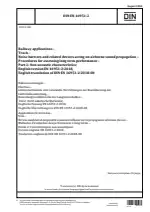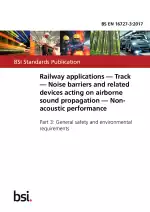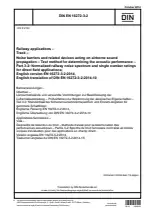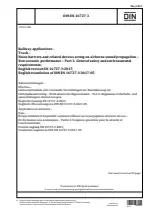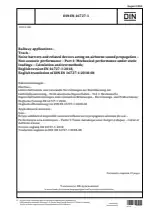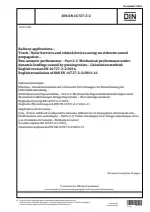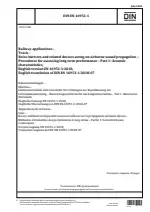Railway Applications - Track - Noise Barriers and Related Devices Acting on Airborne Sound Propagation - Procedures for Assessing Long Term Performance - Part 2: Non-Acoustic Characteristics
Also Known As:
The DIN EN 16951-2 standard outlines the requirements for evaluating the long-term performance of noise barriers and related devices in railway applications.
The standard focuses on assessing the working life and exposure conditions of these barriers and devices. It provides guidelines and procedures for evaluating their non-acoustic characteristics, which refers to aspects beyond sound propagation. These non-acoustic characteristics could include factors such as structural integrity, durability, resistance to weather conditions, and maintenance requirements.
By specifying the requirements for assessing the long-term performance, DIN EN 16951-2 aims to ensure that noise barriers and related devices in railway applications meet the necessary standards for their intended lifespan. This standard provides a comprehensive framework for evaluating the non-acoustic characteristics of these barriers and devices, ultimately contributing to the overall effectiveness and sustainability of noise mitigation measures in railway environments.
| Descriptors | Acoustics, Airborne noise emitted, Airborne sound insulation, Characteristics, Definitions, Diffuse fields, Environmental condition, Evaluations, Infrastructure, Laboratory testing, Life (durability), Life test, Long-time behaviour, Materials testing, Measurement, Measuring techniques, Noise, Noise control (acoustic), Noise (environmental), Noise reduction, Product specification, Protective walls, Rail transport, Railway applications, Railways, Sheeting, Sound fields, Sound insulation measure, Sound propagation, Stress, Superstructure, Testing, Travel ways, Architraves, Sheets, Pavements (roads), Casing, Cages (machines), Permanent ways, Roadways, Mouldings |
| ICS Codes | 93.100 - Construction of railways |
| Language(s) | English |
| File Size | 1.2 MB |

